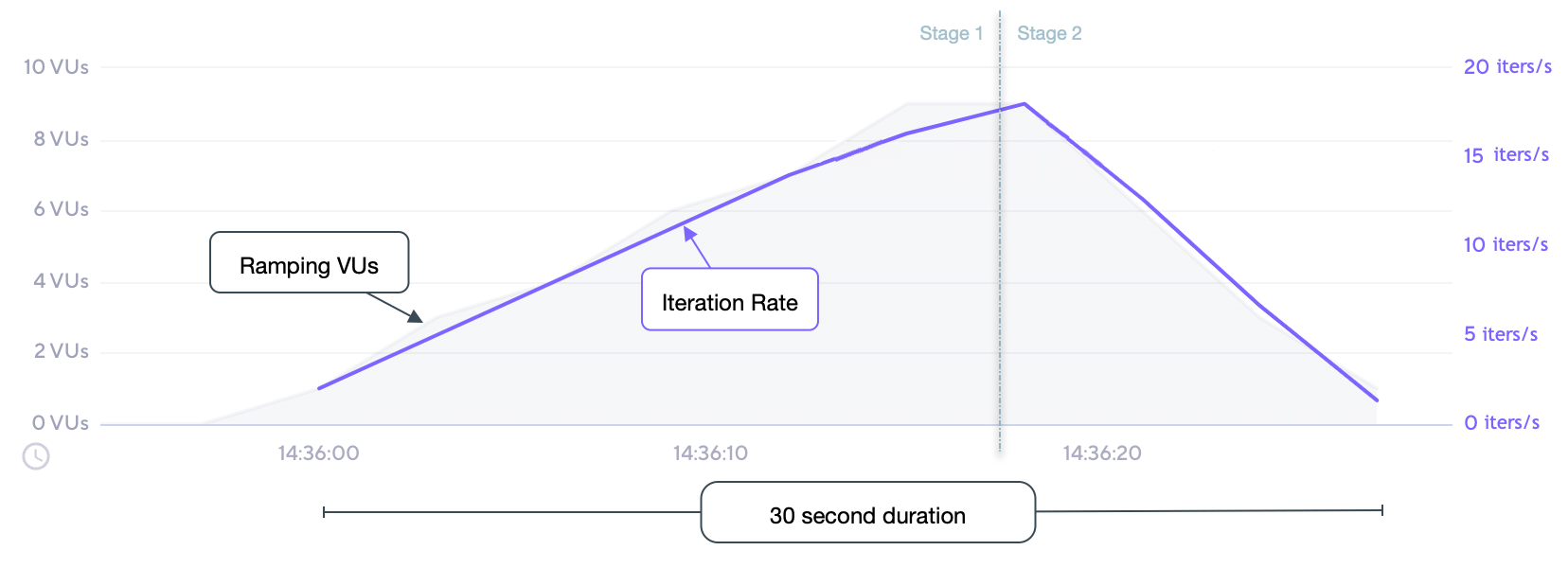Important: This documentation is about an older version. It's relevant only to the release noted, many of the features and functions have been updated or replaced. Please view the current version.
Ramping VUs
With the ramping-vus executor, a variable number of VUs executes as many iterations as possible for a specified amount of time.
For a shortcut to this executor, use the stages option.
Options
Besides the common configuration options, this executor has the following options:
When to use
This executor is a good fit if you need VUs to ramp up or down during specific periods of time.
Example
This example schedules a two-stage test, ramping up from 0 to 10 VUs over 20 seconds, then down to 0 VUs over 10 seconds.
import http from 'k6/http';
import { sleep } from 'k6';
export const options = {
discardResponseBodies: true,
scenarios: {
contacts: {
executor: 'ramping-vus',
startVUs: 0,
stages: [
{ duration: '20s', target: 10 },
{ duration: '10s', target: 0 },
],
gracefulRampDown: '0s',
},
},
};
export default function () {
http.get('https://test.k6.io/contacts.php');
// Injecting sleep
// Sleep time is 500ms. Total iteration time is sleep + time to finish request.
sleep(0.5);
}Note
With
gracefulRampDownset to 0 seconds, some iterations might be interrupted during the ramp down stage.
Observations
The following graph depicts the performance of the example script:

Based upon our test scenario inputs and results:
- The configuration defines 2 stages for a total test duration of 30 seconds;
- Stage 1 ramps up VUs linearly from the
startVUsof 0 to the target of 10 over a 20 second duration; - From the 10 VUs at the end of stage 1, stage 2 then ramps down VUs linearly to the target of 0 over a 10 second duration;
- Each iteration of the
defaultfunction is expected to be roughly 515ms, or ~2/s; - As the number of VUs changes, the iteration rate directly correlates; each addition of a VU increases the rate by about 2 iters/s, whereas each subtraction of a VU reduces by about 2 iters/s;
- The example performed ~300 iterations over the course of the test.
Get the stage index
To get the current running stage index, use the getCurrentStageIndex helper function from the
k6-jslib-utils library. It returns a zero-based number equal to the position in the shortcut stages array or in the executor’s stages array.
import { getCurrentStageIndex } from 'https://jslib.k6.io/k6-utils/1.3.0/index.js';
export const options = {
stages: [
{ target: 10, duration: '30s' },
{ target: 50, duration: '1m' },
{ target: 10, duration: '30s' },
],
};
export default function () {
if (getCurrentStageIndex() === 1) {
console.log('Running the second stage where the expected target is 50');
}
}Using this feature, it is possible to automatically tag using the current running stage. Check the Tagging stages section for more details.

